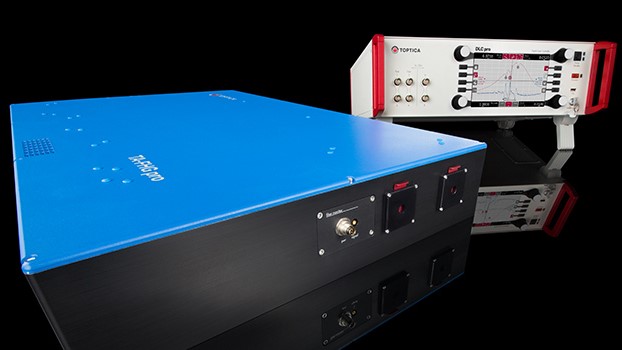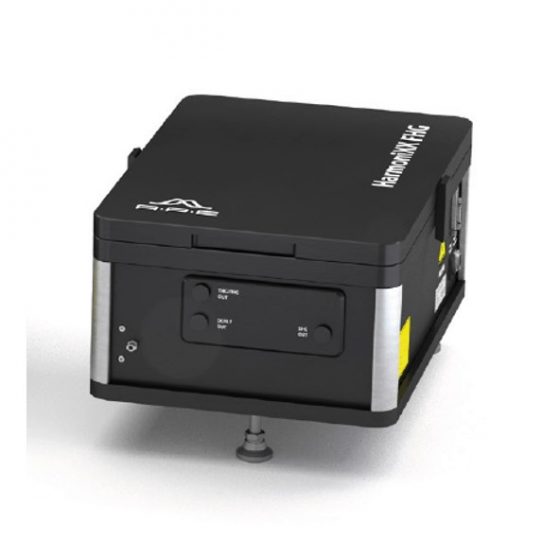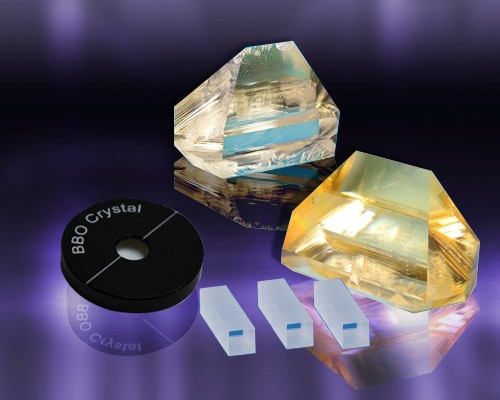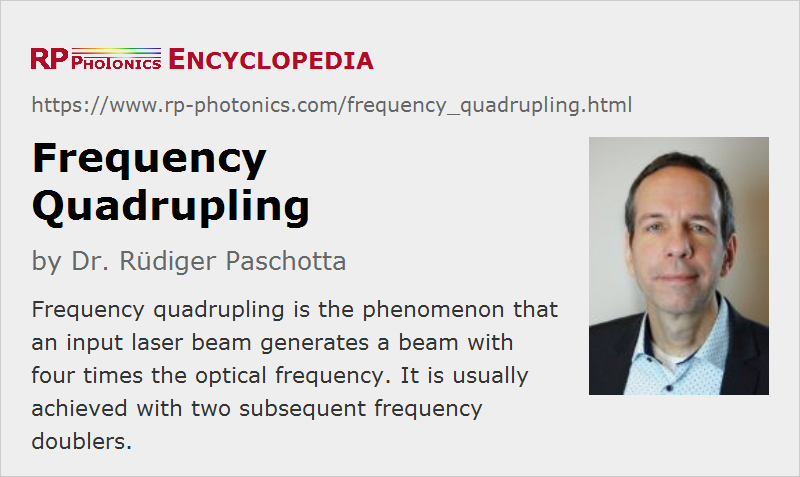Frequency Quadrupling
Definition: the phenomenon that an input laser beam generates a beam with four times the optical frequency
Alternative term: fourth-harmonic generation
More general term: nonlinear frequency conversion
German: Frequenzvervierfachung
Author: Dr. Rüdiger Paschotta
Cite the article using its DOI: https://doi.org/10.61835/ucg
Get citation code: Endnote (RIS) BibTex plain textHTML
Frequency quadrupling is a process of nonlinear frequency conversion where the resulting optical frequency is four times that of the input laser beam, which means that the wavelength is reduced by a factor of 4. That can be accomplished with two sequential frequency doublers (Figure 1). Another possibility would be to use a single frequency doubler and two sum frequency generation stages for mixing with residual pump light, but that approach is not common.

A common type of frequency quadrupling configuration begins with a continuous-wave or pulsed Nd:YAG laser at 1064 nm for generating 532-nm light in a first frequency doubler stage (based e.g. on LBO = lithium triborate) and then 266 nm in a second stage (based e.g. on CLBO = cesium lithium borate). Such ultraviolet light is useful e.g. for pumping a dye laser or an optical parametric oscillator, for Raman spectroscopy in flames, or for laser material processing, e.g. the writing of fiber Bragg gratings.
Limited Lifetime due to Crystal Degradation
As explained in the article on frequency tripling, nonlinear crystals can be degraded during operation by the intense ultraviolet light. For frequency quadrupling, the correspondingly shorter UV wavelength tentatively cause stronger problems of that type, compared with frequency tripling, and lead to short lifetimes of crystals and other optics. Otherwise, similar aspects apply as discussed in the article on frequency tripling.
More to Learn
Encyclopedia articles:
Suppliers
The RP Photonics Buyer's Guide contains 16 suppliers for frequency quadrupling devices. Among them:


TOPTICA Photonics
TOPTICA provides frequency-quadrupled continuous-wave diode and fiber lasers based on two cascaded frequency-doubling stages. Available wavelengths range from 190 nm to 390 nm with up to 10 nm of tuning. Furthermore, the novel Super-UV technology guarantees long-term stable operation and higher powers at DUV wavelengths.


HC Photonics
HC Photonics (HCP) offers both commercial off-the-shelf (COTS) and custom PPMgO:LN or PPMgO:LT based frequency quadrupling devices for pump wavelength ranging from 1420 nm to 5000 nm.
The product mix includes bare crystals and plug-and-play fibered mixers with either one cascaded design or two-stage conversion configurations.
A typical reference spec is the 488 nm fibered mixer converted from 1952 nm fiber laser.
Please contact us for solutions to meet your specific demands.


APE
The HarmoniXX FHG – Fourth Harmonic Generation – is a frequency converter for quadrupling the frequency of ultrashort pulse lasers.
The focus is on user-friendliness and a compact design. By featuring a quick exchange of optics, the HarmoniXX devices can be used for a wide pulse duration range, from femtoseconds (fs) to several picoseconds (ps). All units are optimized for highest conversion efficiency at various laser power levels. They also display minimum pulse broadening while maintaining good spatial beam profile.
For more details, see our specifications.


Shalom EO
Hangzhou Shalom EO offers nonlinear crystals for frequency quadrupling applications, which includes: BBO crystals, KDP and KD*P crystals, in addition to PPLN waveguides. Both off-the-shelf and customized products are available.


EKSMA OPTICS
EKSMA Optics offers a wide variety of nonlinear materials which are well suited for quadrupling applications starting with different laser wavelengths. The most popular choices are BBO and KDP crystals. We also have the even more efficient custom CLBO crystals.
Bibliography
| [1] | J. Reintjes and R. C. Eckardt, “Efficient harmonic generation from 532 to 266 nm in ADP and KD*P”, Appl. Phys. Lett. 30, 91 (1977); https://doi.org/10.1063/1.89300 |
| [2] | D. Bruneau et al., “Fourth harmonic generation of a large-aperture Nd:glass laser”, Appl. Opt. 24 (22), 3740 (1985); https://doi.org/10.1364/AO.24.003740 |
| [3] | B. A. Hooper et al., “Fourth-harmonic generation in a single lithium niobate-crystal with cascaded second-harmonic generation”, Appl. Opt. 33 (30), 6980 (1994); https://doi.org/10.1364/AO.33.006980 |
| [4] | M. Oka et al., “All solid-state continuous-wave frequency-quadrupled Nd:YAG laser”, J. Sel. Top. Quantum Electron. 1 (3), 859 (1995); https://doi.org/10.1109/2944.473671 |
| [5] | J. Knittel and A. H. Kung, “Fourth harmonic generation in a resonant ring cavity”, IEEE J. Quantum Electron. 33 (11), 2021 (1997); https://doi.org/10.1109/3.641318 |
| [6] | T. Kojima et al., “20-W ultraviolet-beam generation by fourth-harmonic generation of an all-solid-state laser”, Opt. Lett. 25 (1), 58 (2000); https://doi.org/10.1364/OL.25.000058 |
| [7] | T. Südmeyer et al., “Efficient 2nd and 4th harmonic generation of a single-frequency, continuous-wave fiber amplifier”, Opt. Express 16 (3), 1546 (2008); https://doi.org/10.1364/OE.16.001546 |
Questions and Comments from Users
Here you can submit questions and comments. As far as they get accepted by the author, they will appear above this paragraph together with the author’s answer. The author will decide on acceptance based on certain criteria. Essentially, the issue must be of sufficiently broad interest.
Please do not enter personal data here; we would otherwise delete it soon. (See also our privacy declaration.) If you wish to receive personal feedback or consultancy from the author, please contact him, e.g. via e-mail.
By submitting the information, you give your consent to the potential publication of your inputs on our website according to our rules. (If you later retract your consent, we will delete those inputs.) As your inputs are first reviewed by the author, they may be published with some delay.

 nonlinear optics
nonlinear optics

Connect and share this with your network:
Follow our specific LinkedIn pages for more insights and updates: